| Taxocrinus Temporal range: | |
|---|---|
 | |
| Fossil of Taxocrinus species (on the right) | |
| Scientific classification | |
| Kingdom: | |
| Phylum: | |
| Class: | |
| Order: | |
| Family: | |
| Genus: | Taxocrinus Phillips, 1843 |

| Taxocrinus Temporal range: | |
|---|---|
 | |
| Fossil of Taxocrinus species (on the right) | |
| Scientific classification | |
| Kingdom: | |
| Phylum: | |
| Class: | |
| Order: | |
| Family: | |
| Genus: | Taxocrinus Phillips, 1843 |

This genus is known in the fossil record from the Silurian period to the Carboniferous period (age range: from 428.2 to 326.4 million years ago). These fossils have been found in United Kingdom, United States, Australia, China, the Czech Republic and Germany. [1]

Crinoids are marine animals that make up the class Crinoidea, one of the classes of the phylum Echinodermata, which also includes the starfish, brittle stars, sea urchins and sea cucumbers. Those crinoids which, in their adult form, are attached to the sea bottom by a stalk are commonly called sea lilies, while the unstalked forms are called feather stars or comatulids, being members of the largest crinoid order, Comatulida.

Charles Wachsmuth was a German-American paleontologist and businessman. After emigrating to the United States, he became a renowned expert on the Paleozoic fossil animals known as crinoids. He and his collaborator, Frank Springer, published numerous articles on the subject and built an exceptional collection of crinoid fossils. The culmination of his work was the two-volume "Monograph of the North American Crinoidea Camerata", coauthored with Springer and published posthumously in 1897.
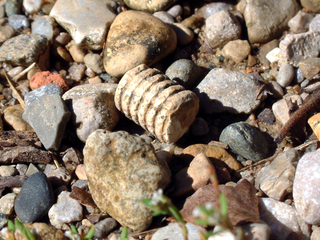
Indian bead is a colloquial American term for a fossilized stem segment of a columnal crinoid, a marine echinoderm of the class Crinoidea. The fossils, generally a centimeter or less in diameter, tend to be cylindrical with a small hole along the axis and can resemble unstrung beads. The fossils are abundant in certain areas, including parts of the American Midwest where they are present in gravel. They are sometimes also referred to as "Indian money".

Sagenocrinites is an extinct genus of crinoid from the Silurian period. During the Silurian period, a sea-covered Britain that was shallower in the south and deeper in the north lay south of the equator with a tropical to sub-tropical climate. Therefore, in the United Kingdom, amongst Silurian fossils, such as brachiopods, trilobites and graptolites, coral-like organisms like sagenocrinites can be found.

Actinocrinites is an extinct genus of crinoids.

Paleontology in Ohio refers to paleontological research occurring within or conducted by people from the U.S. state of Ohio. Ohio is well known for having a great quantity and diversity of fossils preserved in its rocks. The state's fossil record begins early in the Paleozoic era, during the Cambrian period. Ohio was generally covered by seawater from that time on through the rest of the early Paleozoic. Local invertebrates included brachiopods, cephalopods, coral, graptolites, and trilobites. Vertebrates included bony fishes and sharks. The first land plants in the state grew during the Devonian. During the Carboniferous, Ohio became a more terrestrial environment with an increased diversity of plants that formed expansive swampy deltas. Amphibians and reptiles began to inhabit the state at this time, and remained present into the ensuing Permian. A gap in the local rock record spans from this point until the start of the Pleistocene. During the Ice Age, Ohio was home to giant beavers, humans, mammoths, and mastodons. Paleo-Indians collected fossils that were later incorporated into their mounds. Ohio has been the birthplace of many world famous paleontologists, like Charles Schuchert. Many significant fossils curated by museums in Europe and the United States were found in Ohio. Major local fossil discoveries include the 1965 discovery of more than 50,000 Devonian fish fossils in Cuyahoga County. The Ordovician trilobite Isotelus maximus is the Ohio state invertebrate fossil.

Paleontology in Indiana refers to paleontological research occurring within or conducted by people from the U.S. state of Indiana. Indiana's fossil record stretches all the way back to the Precambrian, when the state was inhabited by microbes. More complex organisms came to inhabit the state during the early Paleozoic era. At that time the state was covered by a warm shallow sea that would come to be inhabited by creatures like brachiopods, bryozoans, cephalopods, crinoids, and trilobites. During the Silurian period the state was home to significant reef systems. Indiana became a more terrestrial environment during the Carboniferous, as an expansive river system formed richly vegetated deltas where amphibians lived. There is a gap in the local rock record from the Permian through the Mesozoic. Likewise, little is known about the early to middle Cenozoic era. During the Ice Age however, the state was subject to glacial activity, and home to creatures like short-faced bears, camels, mammoths, and mastodons. After humans came to inhabit the state, Native Americans interpreted the fossil proboscidean remains preserved near Devil's Lake as the bones of water monsters. After the advent of formal scientific investigation one paleontological survey determined that the state was home to nearly 150 different kinds of prehistoric plants.
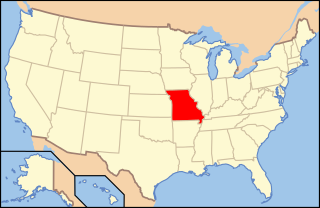
Paleontology in Missouri refers to paleontological research occurring within or conducted by people from the U.S. state of Missouri. The geologic column of Missouri spans all of geologic history from the Precambrian to present with the exception of the Permian, Triassic, and Jurassic. Brachiopods are probably the most common fossils in Missouri.
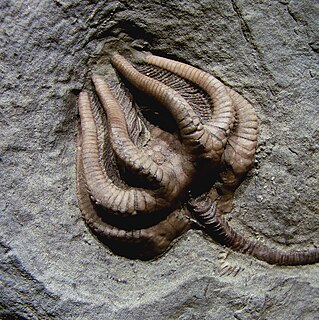
Agaricocrinus americanus, the mushroom crinoid, is a species of extinct crinoid, known only from its fossils, which are found in the U.S. states of Indiana, Tennessee and Kentucky. They date back to the Lower Mississippian, about 345 million years ago.

Bourgueticrinida is an order of crinoids that typically live deep in the ocean. Members of this order are attached to the seabed by a slender stalk and are known as sea lilies. While other groups of crinoids flourished during the Permian, bourgueticrinids along with other extant orders did not appear until the Triassic, following a mass extinction event in which nearly all crinoids died out.
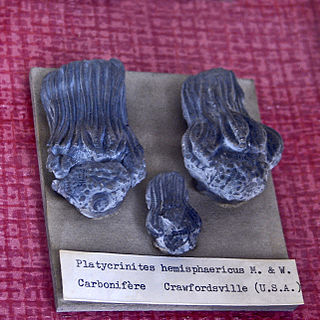
Platycrinites are an extinct genus of Paleozoic stalked crinoids belonging to the family Platycrinitidae.

The Milwaukee Formation is a fossil-bearing geological formation of Middle Devonian age in Milwaukee County, Wisconsin. It stands out for the exceptional diversity of its fossil biota. Included are many kinds of marine protists, invertebrates, and fishes, as well as early trees and giant fungi.
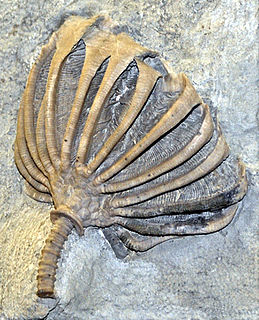
Eretmocrinus is an extinct genus of crinoids.

Forbesiocrinus is an extinct genus of crinoids.
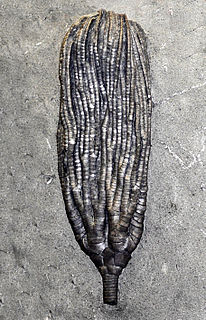
Cydrocrinus is an extinct genus of crinoids.
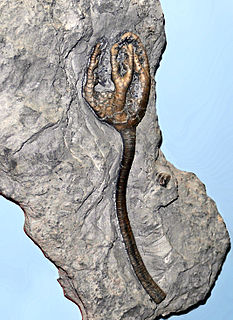
Onychocrinus is an extinct genus of crinoids.
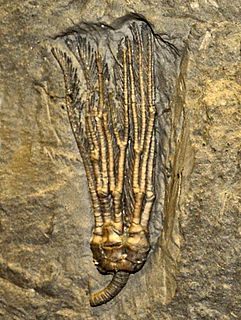
Abrotocrinus is an extinct genus of crinoids.
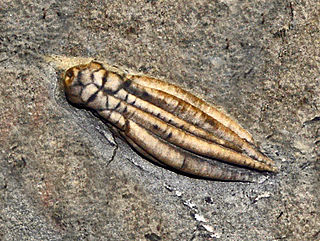
Scytalocrinus is an extinct genus of crinoids.

Ulrichicrinus is an extinct genus of crinoids.